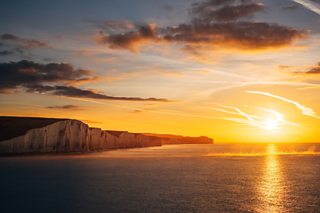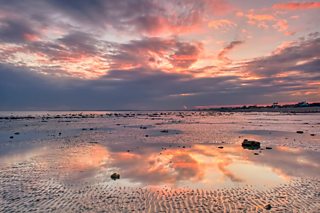Wave after wave of UK ocean conservation news
Marine Conservation Society (MCS)
Partner organisation of the Watches
By Peter Richardson, Head of Ocean Recovery, Marine Conservation Society.
That old adage about waiting for buses comes to mind… we have been waiting for years for good news about UK marine protected areas (MPAs), and so far, in just ten days, June has seen three big announcements come our way.
We welcomed the good news from Secretary of State Michael Gove, on June 3rd, that 41 new Marine Conservation Zones (MCZs) will be designated in seas around England and Northern Ireland. MCZs are a ‘light-touch’ type of MPA, they allow multiple uses of the marine environment so long as those activities do not threaten the ‘features’, meaning those listed species and habitats the MCZ is set up to protect.

The sun casts its rays across the ocean. Photo by Benjamin Davies.
These ‘features’ include an odd mix of obscure and better-known creatures and plants, as well as the places they call home, including common eider ducks, seahorses, black bream, pink sea fans, ocean quahogs, native oyster, stalked jellyfish, tentacled lagoon worms, Ross worm reefs, blue mussel beds, peacock’s tail seaweed, seagrass beds, maerl beds, sub-tidal chalk cliffs, intertidal mud, salt marshes, rocky reefs, sheltered muddy gravels and many more marine species and habitats of which most people are blissfully unaware! There are now 91 MCZs, which contribute to a total of 355 different types of marine protected areas in UK seas.

A short-snouted seahorse. Photo by Paul Naylor.
Just a week later, on June 8th, to coincide with UN World Oceans Day, the Scottish Government launched a 12-week public consultation on its remaining proposed MPAs, including The Sea of The Hebrides, which at more than 10,000km2 promises to be the world’s largest MPA for basking sharks.
If designated these four new sites will also protect minke whales, Risso’s dolphins and the ocean front habitats on which they depend, as well as a suite of vulnerable seabed habitats and species. This consultation is a big deal, as the designation of these sites could mean a long-term future for some of our rarest/precious marine habitats.

A stunning sunset reflects in shallow pools left by the retreating tide on the Sussex coast. Photo by Derek Finch.
Not to be out-done on World Oceans Day, Michael Gove then announced a long-awaited UK Government review to examine whether and how Highly Protected Marine Areas (HPMAs) could be introduced in English seas. HPMAs, or No-Take Zones, are the strongest type of MPA, excluding any form of extraction – and we have only a few very small ones in UK waters. Research around the world has shown HPMAs to be the most effective conservation tool in helping our threatened marine wildlife and habitats recover.
Indeed, the designation of more well-managed MPAs in UK waters, will mean much better protection for our spectacular marine wildlife and the vulnerable seabed it depends on.
